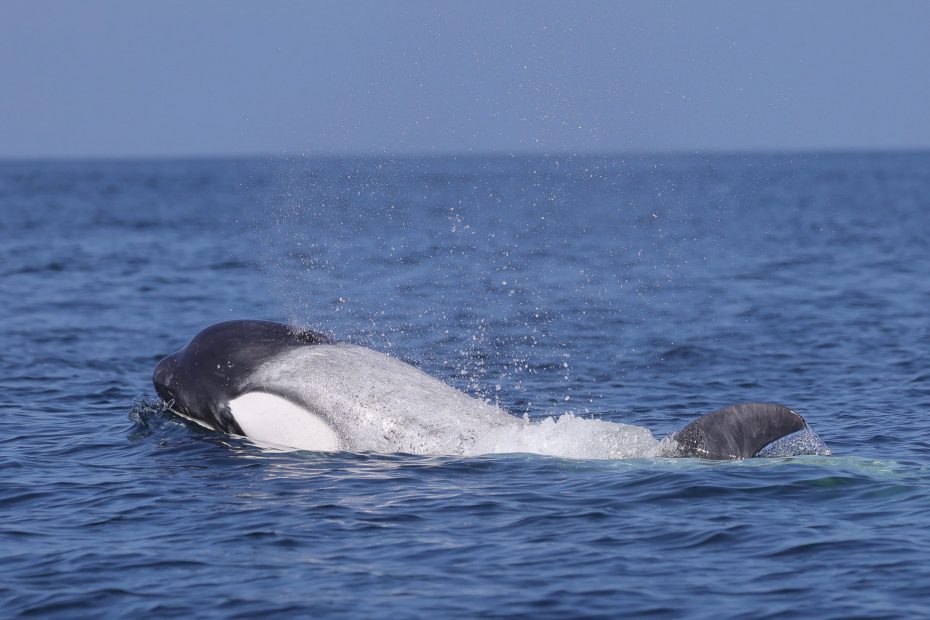An extremely rare white killer whale has been caught on camera as scientists believe the beast has a “brilliant mutation”.
The real-life Moby Dick, nicknamed Frosty because of his snow-white flesh, was spotted on Monday in Newport Beach in California, United States.
The crew of the Catallac, a whale watching boat operated by Davey’s Locker and Newport Landing, captured the unique interaction nine miles offshore.
The incredible footage shows the ghostly whale swimming with a pod of around seven orcas and munching on an unknown animal.
The crew said orca sightings are rare and they were excited about the “special encounter” with the four-year-old calf.
Captain Dani Fasser said: “We were very lucky and were able to locate a pod of at least five to seven orcas, one of which was a four-year-old calf named Frosty, for its milky white appearance.
“Passengers watched in amazement as the orcas passed right under the boat!
“The killer whales fed on a beach ball-sized piece of an unknown animal, probably a dolphin or small whale, and passed it back and forth, feeding together.
“Orca sightings are few and far between along the Southern California coast, so it was a very special encounter.”
The orca, which resembles the white beast from Herman Melville’s 1851 novel Moby Dick, could be one of only ten ever recorded in history.
The animal can be seen submerging and emerging again, with the color of its body standing out starkly against that of its companions.
The unusualness could be explained by a genetic condition that likely caused a loss of color and resulted in the creature’s milky complexion appearance.
Jessica Roame, director of education at Davey’s Locker & Newport Landing, said: “It is suspected that this orca may have a rare genetic disease called leucism, a condition that results in a partial loss of pigmentation.
“This causes a white, pale or patchy coloration of the skin, hair, feathers or scales, but not the eyes.
“It’s extremely rare: the information I’ve read suggests that scientists have documented only about 10 recorded white orcas in history.
“Because there are so few white orcas, not much information is known about their specific genetic condition.”
The genetic condition also gives the orca a shiny mutation that makes it easier to detect underwater.
Jessica added: “Frosty’s white coloring is so striking in person that it produces a beautiful green glow underwater.
“So you can still easily see this whale as it swims beneath the surface.”
Jessica was delighted with her experience with the animal, which she described as “awesome.”
She said: “When Captain Fasser first noticed the bushy strikes out of the corner of his eye, he thought, ummm, that’s not a dolphin squirt or a baleen whale squirt.
“As he trained his binoculars on the orca spouts, he knew exactly what he was looking at and exclaimed ‘My God! It’s finally happening.’
“Being in the presence of such powerful and beautiful animals is inexplicable and literally takes your breath away.
“I know many people will come away from this experience with a lot of gratitude in their hearts for the wonders of the ocean.”
THE WILDEST ATTACKS OF THE ORCHAS

Orcas, despite their name, have been involved in very few recorded attacks on humans, at least in the wild.
But when kept in captivity, these majestic creatures can become violent or even deadly.
On April 20, 1971, SeaWorld public relations secretary Annette Eckis was supposed to ride an orca in a bikini for a publicity stunt.
But after a few moments, Annette slid off the creature’s back and Shamu grabbed her leg with its jaws.
He swam around the tank, dragging the screaming woman with him and refusing to let her go.
Kasatka, a 30-year-old orca, was said to have become agitated upon hearing her calf scream as she pulled Ken Peters and dragged him underwater at the attraction in San Diego, California.
The 5,000-pound beast held the trainer underwater twice as it grabbed his foot and went under for less than a minute each time.
Kasatka eventually let him go, but he suffered a broken foot and puncture wounds.
The body of Daniel Dukes, 27, was discovered covered in scratches and bruises, on top of Tilikum, the largest orca in captivity.
Dukes had suffered hypothermia and drowned after staying in the park after opening hours.
It is not yet known whether he jumped, fell or was pushed into the huge tank by Tilikum.
Dawn Brancheau, 40, a veteran animal trainer, had always dreamed of working at SeaWorld Florida.
But on February 24, 2010, she was tragically killed by an orca in front of horrified tourists.
SeaWorld said Tilikum, a 26-year-old man, grabbed her by the upper arm, threw her into his mouth and dragged her under the water.




